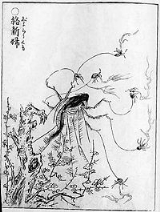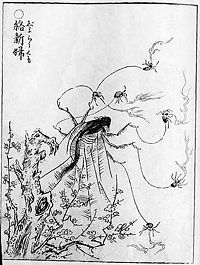
Jorogumo
Encyclopedia

Yōkai
are a class of supernatural monsters in Japanese folklore. The word yōkai is made up of the kanji for "otherworldly" and "weird". Yōkai range eclectically from the malevolent to the mischievous, or occasionally bring good fortune to those who encounter them...
, a creature, ghost or goblin of Japanese folklore
Japanese folklore
The folklore of Japan is heavily influenced by both Shinto and Buddhism, the two primary religions in the country. It often involves humorous or bizarre characters and situations and also includes an assortment of supernatural beings, such as bodhisattva, kami , yōkai , yūrei ,...
. According to some stories, a Jorōgumo is a spider
Spider
Spiders are air-breathing arthropods that have eight legs, and chelicerae with fangs that inject venom. They are the largest order of arachnids and rank seventh in total species diversity among all other groups of organisms...
that can change its appearance into that of a seductive woman.
In Japanese Kanji, Jorōgumo is written as "" (literally meaning "binding lady") or "" (literally meaning "whore spider"). Jorōgumo can also refer to some species of spiders but in casual use it can refer to the Nephila
Golden silk orb-weaver
The golden silk orb-weavers are a genus of araneomorph spiders noted for the impressive webs they weave. Nephila consists of numerous individual species found around the world. They are also commonly called golden orb-weavers, giant wood spiders, or banana spiders...
and Argiope
Argiope (spider)
The genus Argiope includes rather large and spectacular spiders that have often a strikingly coloured abdomen. These are well distributed throughout the world, and most countries in temperate or warmer climates have one or more species, which look similar....
spiders. Japanese-speaking entomologists use the katakana
Katakana
is a Japanese syllabary, one component of the Japanese writing system along with hiragana, kanji, and in some cases the Latin alphabet . The word katakana means "fragmentary kana", as the katakana scripts are derived from components of more complex kanji. Each kana represents one mora...
form of Jorōgumo to refer, exclusively, to the species Nephila clavata
Nephila clavata
Nephila clavata, also known as the , is a member of the golden orb-web spider group. The spider can be found throughout Japan except Hokkaidō, in Korea, Taiwan and China...
.
Stories
The Edo periodEdo period
The , or , is a division of Japanese history which was ruled by the shoguns of the Tokugawa family, running from 1603 to 1868. The political entity of this period was the Tokugawa shogunate....
legend has it that a beautiful woman would entice a man into a quiet shack and begin to play a Biwa
Biwa
The is a Japanese short-necked fretted lute, often used in narrative storytelling. The biwa is the chosen instrument of Benten, goddess of music, eloquence, poetry, and education in Japanese Shinto....
, a type of Japanese lute. While the victim would be distracted by the sound of the instrument, she binds her victim in spider silk threads in order to devour the unsuspecting person as her next meal.
According to legend, when a spider turns 400 years old, it gains magical powers. Stories of Jorōgumo can be found in Edo period works such as "Taihei-Hyakumonogatari" and "Tonoigusa" . In many of these stories, Jorōgumo changes its appearance
Shapeshifting
Shapeshifting is a common theme in mythology, folklore, and fairy tales. It is also found in epic poems, science fiction literature, fantasy literature, children's literature, Shakespearean comedy, ballet, film, television, comics, and video games...
into a beautiful woman to ask a samurai
Samurai
is the term for the military nobility of pre-industrial Japan. According to translator William Scott Wilson: "In Chinese, the character 侍 was originally a verb meaning to wait upon or accompany a person in the upper ranks of society, and this is also true of the original term in Japanese, saburau...
to marry her, or takes the form of a young woman carrying a baby (which may turn out to be a spider's eggsack).
Drawings, such as the one in Toriyama Sekien
Toriyama Sekien
thumb|200px| was an 18th century scholar and ukiyo-e artist of Japanese folklore. He was the teacher of Utamaro and, before taking up printmaking, a painter of the Kanō school. Toriyama is most famous for his attempt to catalogue all species of yōkai in the Hyakki Yakō series.-References:...
's"Gazu Hyakki Yakō", depicts Jorōgumo as a half-woman/half-spider surrounded by her spider children.
A Jorōgumo is also known as the mistress of the Jōren waterfall in Izu
Izu, Shizuoka
is a city located in central Izu Peninsula in Shizuoka, Japan. As of 2009, the city had an estimated population of 35,397 and the density of 97.3 persons per km². The total area as 363.97 km².-Geography:...
, Shizuoka
Shizuoka Prefecture
is a prefecture of Japan located in the Chūbu region on Honshu island. The capital is the city of Shizuoka.- History :Shizuoka prefecture was formed from the former Tōtōmi, Suruga and Izu provinces.The area was the home of the first Tokugawa Shogun...
. The legend has it that a man was resting at the foot of the waterfall when his feet were bound with a vast number of spider threads. To free himself, he cut the threads and tied them to a stump of a tree, which was pulled from the ground and drawn into the waters.
After this incident at Jōren waterfall, the villagers became afraid and stopped going to the waterfall. However, one day, a woodsman
Lumberjack
A lumberjack is a worker in the logging industry who performs the initial harvesting and transport of trees for ultimate processing into forest products. The term usually refers to a bygone era when hand tools were used in harvesting trees principally from virgin forest...
from out of town, unaware of the story of the Jōren Jorōgumo, began cutting wood in the area. When he accidentally dropped his axe into the water, he dove into the pool to find it, and a beautiful woman appeared and returned the axe, telling him never to tell anyone about her
Yuki-onna
is a spirit or yōkai in Japanese folklore. She is a popular figure in Japanese literature, manga, and animation. Yuki-onna is sometimes confused with Yama-uba , but they are not the same.-Appearance:...
. While the logger kept the promise, he began to feel anxious about the incident. One day, while drunk, he told his secret and, finally feeling at ease, fell into a deep sleep never to awaken again.
In a variation of the story of the Jōren waterfall, the logger falls in love with the woman and starts visiting the falls every day to see her. But as time passes, he starts growing weaker and weaker. A monk from a neighboring temple believes the logger has been trapped by the spider, so he and the logger go to the waterfall together, and the monk reads a Buddhist Sūtra
Sutra
Sūtra is an aphorism or a collection of such aphorisms in the form of a manual. Literally it means a thread or line that holds things together and is derived from the verbal root siv-, meaning to sew , as does the medical term...
there. While the monk reads the sutra, spider threads appear from the pool and attempt to wrap themselves around the logger, but the monk shouts his Buddhist chant and they disappear. Though the logger soon realizes that the woman was a spider, he cannot forget his love for her, so he asks a Tengu
Tengu
are a class of supernatural creatures found in Japanese folklore, art, theater, and literature. They are one of the best known yōkai and are sometimes worshipped as Shinto kami...
, master of the Yōkai of the mountain, for help, but the Tengu does not allow this love. The logger, unwilling to give up his love for the Jorōgumo, runs back to the waterfall, is finally caught by the silk threads, and falls into the water, never to surface again.
There are many stories throughout Japan of a stump being pulled into the water in place of the lumberjack. One such example is that of Kashikobuchi , Sendai. Here, just after the stump is pulled into the pool, the lumberjack hears a voice saying, "How clever, how clever" ( / Kashikoi, Kashikoi). For this event, the area came to be called Kashikobuchi, which literally means "clever abyss,". In Kashikobuchi the Jorōgumo is worshiped as a goddess who protects people from drowning, and a monument and a small Torii
Torii
A is a traditional Japanese gate most commonly found at the entrance of or within a Shinto shrine, where it symbolically marks the transition from the profane to the sacred...
still stand at the location.
In popular culture
- Hanns Heinz Ewers' short story "The Spider" (1919) centers around a mysterious girl whom the protagonist names Clarimonda. She is an early appearance in Western literature of the concept of a Jorōgumo.
- In the short story "Magic Dreams" by Ilona Andrews, the main villain is Jorōgumo.
- Also in Tanizaki Junichiro's short story "Tattoo" which is about a sadistic tattooist Seikichi who draws the Jurogumo on an innocent maiko's (apprentice geisha) back which somewhat awakens an evil streak in her.
Further reading
See also
- List of legendary creatures from Japan
- TsuchigumoTsuchigumoThe , also called , were a people of ancient Japan, believed to have lived in the Japanese Alps until at least the Asuka period. The name means "ground spider", likely due to perceived physical traits that were later exaggerated or embellished....

